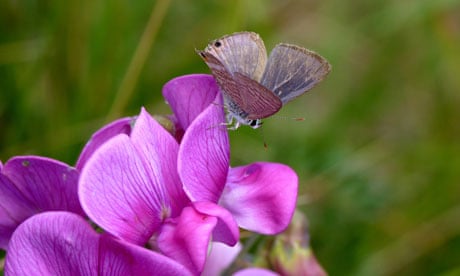It is not blue birds but the long-tailed blue that has been found flying over the White Cliffs of Dover.
The rare migratory butterfly has settled on chalk grassland owned by the National Trust and laid eggs, leading lepidopterists to hope for a spectacular late-summer emergence of the exotic insect on British soil.
A vivacious little creature with distinctive tails on its wings, the long-tailed blue is found across Africa, southern Asia and Australia but it cannot survive the winters further north than the Mediterranean.
In the 20th century, it only reached Britain in significant numbers twice – in 1945 and 1990 – but it has a talent for popping up in unusual places. In 1990, it appeared in Kensal Green Cemetery in north-west London and laid eggs in Gillespie Park, by Arsenal's football ground. In 2003, the butterfly laid eggs on the North Downs close to Denbies vineyard.
This year the long-tailed blue has been seen in Hampshire, Sussex, Suffolk and as far north as Derbyshire, and has colonised almost a mile stretch of the White Cliffs at Kingsdown Leas, east of Dover. Ironically, here the rare butterfly has laid eggs on Lathyrus latifolius, everlasting pea, an invasive escapee from gardens considered a pest by conservationists, who seek to remove it from native flower-rich chalk grassland.
Other unusual migratory butterflies including large numbers of clouded yellows, the continental swallowtail and Queen of Spain fritillaries have invaded southern England in what has been one of the best summers for many insects for a decade.
"It's all happening," said Matthew Oates of the National Trust. "There's been some really wacky migrants. This is a deeply memorable butterfly year."
If conditions remain fine, the eggs laid by the long-tailed blues on the White Cliffs should emerge as adult butterflies by late September.
According to Richard Fox of Butterfly Conservation, if there is an Indian summer with gentle winds coming up from southern Europe, the influx of migrant insects may get even more notable with a potential influx of monarch butterflies and spectacular moths including the death's head hawkmoth and the crimson speckled.
While the long-tailed blues on the White Cliffs will have flown in from the continent during recent fine weather, Fox warned that isolated sightings of the long-tailed blue may be individuals which have snuck into Britain as caterpillars on imported vegetables. "It's not unusual for people to report caterpillars from fresh peas, mange tout or green beans bought in British supermarkets which turn out to be long-tailed blues," he said.

Comments (…)
Sign in or create your Guardian account to join the discussion